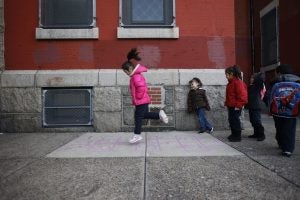Which Pa. school districts get the highest percentage of aid from the state?
If you guessed Philadelphia, you’d be dead wrong.
Fifth in an occasional series of podcasts and web “explainers.”
Which school districts in Pennsylvania receive the most state funding as a share of their total revenue?
If you guessed Philadelphia, you’d be dead wrong.
As the interactive map above shows, the Philadelphia School District (85 percent economically disadvantaged) is nowhere near the top of the list.*
Rural districts in Western Pennsylvania dominate this category.
Meyersdale School district (45 percent economically disadvantaged) gets 73 percent of its revenue from the state.
Valley Grove School District (56 percent economically disadvantaged) gets about 72 percent of its revenue from Harrisburg.
Tussey Mountain School District (58 percent economically disadvantaged) receives about 70 percent of its funding from the state.
Districts in the far Northeast section of the commonwealth also receive a large portion of their school budgets from the state.
Northeast Bradford School District (47 percent economically disadvantaged) gets 68 percent of its funding from Harrisburg.
Susquehanna Community School District (58 percent economically disadvantaged) also gets about 68 percent.
What drives these numbers?
Pennsylvania’s lack of a predictable, student weighted funding formula allows state tax dollars to flow through Harrisburg in a largely irrational manner. Districts with more students in poverty, more special education students, and more english language learners don’t formulaically receive additional state aid to help cover the added costs of meeting the needs of those students. If such a formula were implemented, urban districts like Philadelphia, Allentown and Reading would see a boost, while many rural and suburban districts would likely receive less state revenue.
Lawmakers dole out education spending largely based on what a district received the year prior. This “hold harmless” provision means that even if a district loses enrollment, the state will not reduce its share of aid.
In some cases, districts with stronger connections to state political power get funding boosts not enjoyed by other districts.
It’s important to stress here that this analysis looks at the percentage of funding sources, not overall dollar amounts.
In total dollars, Philadelphia receives the most state aid by far. But it has, by far, the most students — serving about 203,000 kids in district-and-charter-run public schools.
The next most populated district is Pittsburgh, which serves 26,000 students.
To have and to have not…
Overall, the state’s poorest urban districts receive less state aid as a percentage of total funding than the state’s rural districts.
The exception is the Reading School District (93 percent economically disadvantaged), which tops the list with 73.3 percent of its funding coming from Harrisburg.
Chester Upland (82 percent economically disadvantaged) gets 66 percent.
York City (84 percent economically disadvantaged) gets about 57 percent from the state.
Allentown (88 percent economically disadvantaged) gets about 53 percent.
Erie (80 percent economically disadvantaged) gets about 54 percent from Harrisburg.
Wealthy suburbs of Philadelphia and Pittsburgh receive the least state aid.
School districts in Radnor and Lower Merion get about 11 percent of their funding from the state. Fox Chapel Area School District gets about 16 percent.
Some urban education advocates question why these districts need to receive any state aid at all.
The map above reveals a few other standouts. The Wallenpaupack School District (52 percent economically disadvantaged) gets only 21 percent of its funding from Harrisburg.
Jim Thorpe School District (50 percent economically disadvantaged) gets only 17 percent.
Akin to Philadelphia’s situation, Delaware County’s William Penn School District (79 percent economically disadvantaged) gets about 41 percent.
*The data in this map is based on information from 2012-13. In that year, the Philadelphia School District borrowed $300 millon to plug thier budget, in effect driving down the percent of total aid that it recieved from the state that year. The map above shows the state’s share to be 45 percent. Typically, the state gives a little more than half.
In the Multiple Choices podcast, Keystone Crossroads senior education writer Kevin McCorry joins with Paul Socolar, publisher and editor of the Public School Notebook, and Notebook contributing editor Dale Mezzacappa to explain and explore the history, complexities and controversies of public education funding in Pennsylvania.
Look for new installments of Multiple Choices every week for the rest of the spring, as the General Assembly reviews Gov. Wolf’s ambitious school funding and tax plan.
WHYY is your source for fact-based, in-depth journalism and information. As a nonprofit organization, we rely on financial support from readers like you. Please give today.





